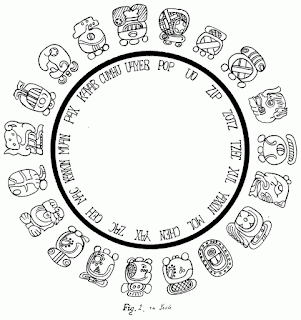The Maya, who practiced a cosmological and ritualistic religion, had strong religious beliefs in the cycles of life, death, creation and destruction. Part of the Mayan religion revolved around blood sacrifices offered to the gods and goddesses that they worshiped. Another facet of their belief system was their well thought-out concepts of space and time. These concepts were made famous in their elaborate calendar system.
The Maya saw time as both linear and cyclical and had two main calendar-like systems to map these different timeframes. Like the months and the year of the Gregorian calendar, the Mayan calendar was based upon the repetition of seasons and events in the cosmos. The Maya calculated time in two cycles, a short, cyclical cycle called the Calendar Round, and a long, linear cycle called the Long Count.
The shorter measure of time was calculated by a calendar cycle of fifty-two years, or 18,980 days, and was called the Calendar Round. It was a combination of two smaller calendar measurements called the Sacred Round (Tzolkin) and Haab’ cycles. The first was based on a ‘month’ of 20 days that were connected like a wheel with the numbers from 1 to 13, giving a complete cycle of 260 days. This system was used for scheduling religious ceremonies and giving birth dates. The Haab’ cycles were based on the movement of the sun. This calendar had 18 month of 20 days, making a cycle of 360 days to which were added extra 5 days to coincide with the solar cycle. These 5 extra days were the time of great uncertainty for the Mayans. To make sure this time passes without much trouble, there were many human sacrifices to the Sun god during this period. So, each day had 2 dates – according to the each calendar. Tzolkin and Haab’ coincided every 52 years. End of each cycle was a time of even greater uncertainty for Maya…
The longer phases of time were measured by the Long Count calendar. It is said to record the world’s creation, even though the Mayans did not consider this to be the beginning of time. Each day of the Long Count has a unique number, commonly represented as five digits separated by periods, such as 1.2.4.9.11. Each number represents specific units of chronological measurement, largest to smallest, from left to right. The units are: baktun (144,000 days), katun (7,200 days), tun (360 days), winal (20 days), and kin (1 day). The number of days indicated by the five digits is equal to the number of days since the Mayans believed the world was created.
Through mathematical calculations, scholars have been able to convert the dates of the Long Count calendar to those of the Gregorian calendar. They generally agree that the beginning date is August 11, 3114 BCE; according to Mayan belief, this date marks the creation of the world. It is represented as 13.0.0.0.0, where the thirteen serves as a zero. The calendar covers 13 baktun, or 187,200 days (5,125 years). At the end of the time span, the calendar dating system will once again read 13.0.0.0.0. This date will be the anniversary of the creation of the world. The parallel Gregorian calendar date is December 21, 2012. However, unlike the popular beliefs of the end of the world surrounding the 2012 phenomenon, the Mayans never had an explicit prophecy regarding what would happen when the calendar ended.
Anyway, even if the world is going to end, may be somewhere, but not here at Black Orchid Resort. You are kindly welcome to our eco-friendly jungle resort in Belize any time in 2013 and in any of the next years!




Great information.Thanks for sharing this useful information with all of us. Keep sharing more in the future.
ReplyDeletemayan calendar
Great information.Thanks for sharing this useful information with all of us. Keep sharing more in the future.
ReplyDeletetzolkin calendar